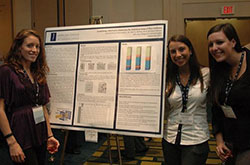Celebrating Student Research
2025 SOFT Educational Research Award (ERA) Recipient
Seokjin Hwang
The SOFT Educational Research Award was conceived in 1978 by Dr. Vincent Lynch of Saint John's University to demonstrate the Society’s support of academic training programs and research in forensic toxicology. The ERA was approved by the Board of Directors in December 1978, and established an Awards Committee to review applications and select Award recipients. The first ERA, funded by a grant from Hoffman LaRoche, was made in 1980. This competitive award recognizes the outstanding work of students whose research exemplifies innovation, rigor, and impact in the field of forensic toxicology.

2025 - Society of Hair Testing Annual Scientific Meeting
June 4-6, 2025, London, UK

Justin Allen presenting his master thesis research as an oral presentation at the SoHT conference, and Ashef Ameer as co-chair of the scientific session.
2025 - The European Academy of Forensic Sciences (EAFS) Annual Scientific Meeting
May 26-30, 2025, Dublin, Ireland

Deanna Corsetti presenting her master thesis research as an oral presentation at the EAFS conference.
2025 - American Academy of Forensic Science 77th Annual Scientific Meeting
February 17-22, 2025, Baltimore, MD
Maria Mayol presenting master thesis research as a poster at the AAFS conference.

Deanna Corsetti presenting master thesis research as an oral presentation at the AAFS conference.
2024 - Society of Forensic Toxicologists
October 29-November 1, 2024, St. Louise, MO
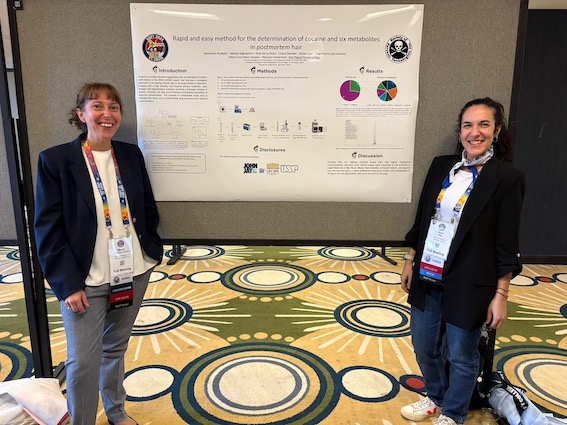
Dr. Concheiro and Dr. Pego presenting a poster at the conference.

Dr. Concheiro, Dr. Pego, Gisselle Rosas and Alexis Palma at the conference.
2024 - Northeastern Association of Forensic Scientists
October 21-25, 2024, Atlantic City, NJ
Dr. Diaczuk and Natalia Aguilar at the conference.
Maria Mayol and Ethan Frazer presenting their posters at the conference.
2024 The Association of Firearm and Tool Mark Examiners (AFTE) Scholarship Awardee
Ethan Frazer
Ethan Frazer is currently pursuing his Master’s degree in Forensic Science with a specialization in Criminalistics from John Jay College of Criminal Justice. Prior to this, he graduated from Laurentian University in Sudbury, Canada with a Bachelor's Degree in Forensic Science. He is also an active member of the Canadian Society of Forensic Science. Currently, Ethan is researching issues presented by polymer-coated bullets and looking at alternative methods of linking these bullets to a suspect firearm. Ideally, this research will assist firearms examiners who are tasked with analyzing evidence related to this unique ammunition. Outside of academics, Ethan volunteers in elementary and high schools to speak about the role of forensic science in our justice system. This fall, Ethan will begin a position as an adjunct lecturer at John Jay College where he attends currently. After completing his degree, Ethan would like to work as a Firearms Examiner while also continuing to perform research within the field. Someday, Ethan would like to work internationally, such as in Europe or Africa, to assist in the sharing of forensic knowledge.

2024 - American Academy of Forensic Science 76th Annual Scientific Meeting
February 19th–24th, 2024, Denver, Colorado
Student: Devyn Pirtle
Professor: Dr. Mechthild Prinz
Talk: Global survey on activity level DNA evaluative reporting
For many criminal cases, the question raised in court may not be who is the source of the DNA evidence, but rather how the DNA was deposited at the crime scene. Forensic scientists know about factors affecting DNA deposits and recovery, and can provide answers based on a formal activity level evaluation, but there are concerns if that should be the scientist’s role. Devyn Pirtle conducted a survey collecting forensic practioners’ opinions on this topic. The majority of answers supported the implementation of evaluative reporting for DNA cases and thought this would be admissible in court.
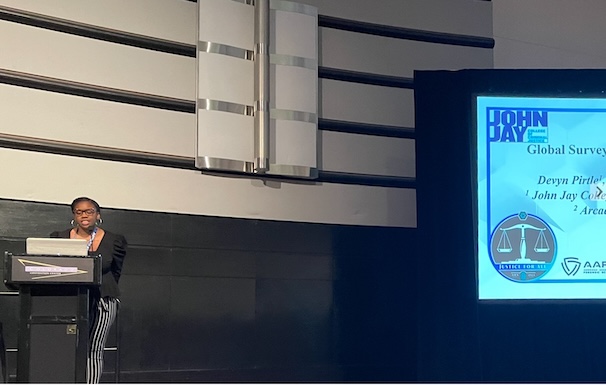
2024 - American Academy of Forensic Science 76th Annual Scientific Meeting
February 19th–24th, 2024, Denver, Colorado
Student: Emily Sam-Zee-Moi
Professor: Dr. Mechthild Prinz
Poster: Dry vacuum recovery of DNA from fabric
The purpose of this study was to determine if a nondestructive dry vacuum technique would be successful at recovering trace DNA from fabric. Trace DNA on outer clothes can be important evidence in groping and assault cases. Emily used glass pipette closed with a cotton swab and 1000mL filter tips to remove biological particles from cotton fabric touched by a set of volunteers. The method was very successful. All samples yielded sufficient DNA for STR analysis. There was no significant difference between the DNA concentrations obtained with either plastic or glass pipettes.
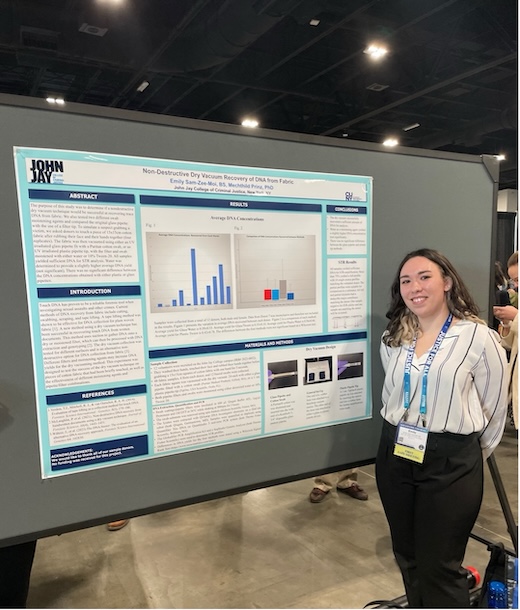
2023 – North Eastern Association of Forensic Scientists
November 6-10, 2023, Groton, CT
Student: Kuanwei Lu
Professor: Dr. Mechthild Prinz
Poster: DNA degradation in saliva swabs stored at room temperature for two different swabbing solutions
Body fluids like saliva can be important evidence in a criminal case. Saliva stains are typically removed from evidence items using a moist swab and then stored in paper bags and at room temperature. Sample Keeper (Microread Genetics, Beijing) is a proprietary buffer marketed as a DNA stabilizing agent during room temperature storage. Kuanwei Lu compared the stability of saliva stains collected with water to Sample Keeper over six months of storage. After DNA extraction Kuan determined the DNA concentration for two autosomal fragments of different sizes. The ratio between the small and the large fragment is an indicator for DNA degradation. Samples swabbed with water were more degraded for all storage times. Degradation increased after 60 days, but the Sample Keeper buffer provided some degree of protection.
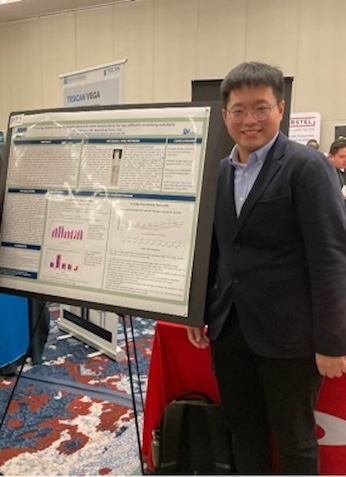
2023 – Society of Forensic Toxicologists
October 31st – November 3rd, 2023, Denver, Colorado
Student: Bridget O’Leary
Professor: Dr. Marta Concheiro-Guisan
Platform presentation: Impact of Blood Preservatives and Anticoagulants on Cannabinoid Quantitative Analysis
The expanded use of recreational and medicinal cannabis products, as well the appearance of new cannabinoid derivatives, increases the importance of implementing pre-analytical (sample collection) protocols and recommendations for cannabinoid testing in biological samples. The accurate quantification of cannabinoids in biological samples is critical for providing a correct result interpretation, especially if specific thresholds have been legally set as in drugs and driving cases in certain states. The objective of this study was to evaluate the impact of different preservatives and anticoagulants in quantitative analysis of 9 different cannabinoids in blood samples stored at room temperature (RT) and at 4℃ up to one month.
Bridget was also awarded the SOFT Educational Research Award.
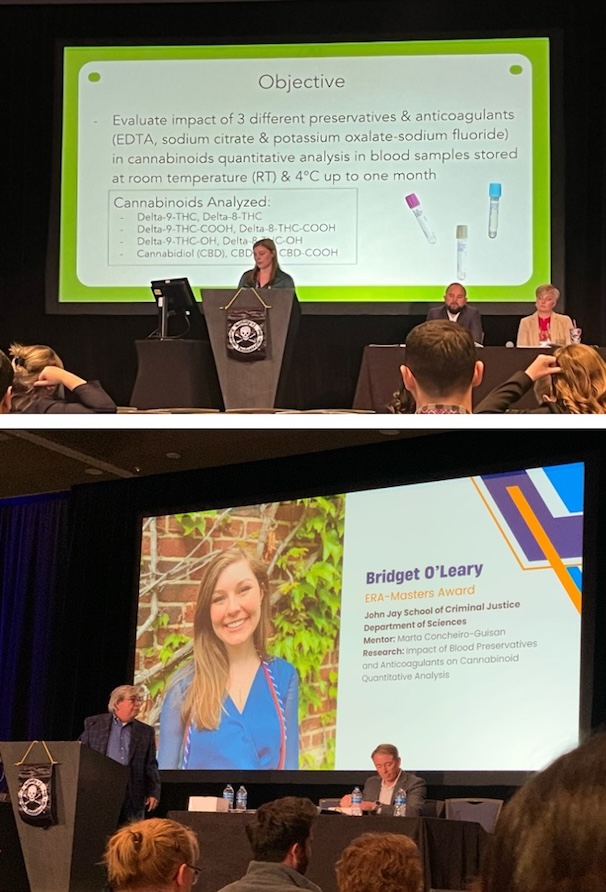
2023 - The International Association of Forensic Toxicologists
August 27th–31st, 2023, Rome, Italy
Student: Emily Pagano
Professor: Dr. Marta Concheiro-Guisan
Poster: Determination of Cannabidiol Metabolites in Umbilical Cord to Detect Cannabidiol Use During Pregnancy
Cannabis and related products consumption has been increasing worldwide among pregnant women. Due to the negative effects of prenatal cannabis exposure, it is necessary to develop an objective, sensitive and specific method to determine cannabinoids use during pregnancy. In this study, we developed an analytical method for the determination of delta-9-tetrahydrocannabinol, cannabidiol, and their metabolites in umbilical cord by liquid chromatography tandem mass spectrometry, and we applied it in the analysis of authentic samples from pregnant women who used cannabis during pregnancy.
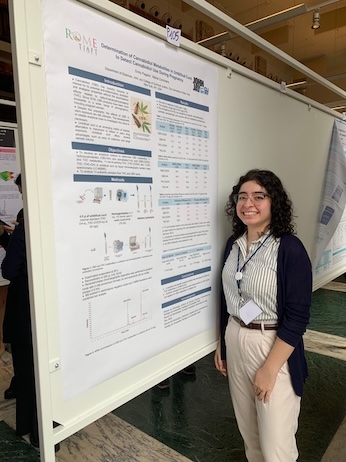
2023 - The International Association of Forensic Toxicologists
August 27th–31st, 2023, Rome, Italy
Student: Marialejandra Faure Betancourt
Professor: Dr. Ana Pego
Poster: The Impact of Dry Shampoo and Gel Treatments on In-Vitro Cocaine Hair Contamination
Hair external contamination poses a major challenge in interpreting drug testing results. Although past studies explored the effect of cosmetic treatments on removing drugs from within the hair shaft, little is known about their influence on the external contamination process. This knowledge gap highlights the need for further investigation to understand how cosmetic treatments impact external hair contamination and to enhance the accuracy and reliability of drug testing results. This study aimed to investigate the impact of dry shampoo and gel treatments on the external contamination of cocaine and determine if these treatments prevent or reduce contamination in hair samples of varying shapes and colors.
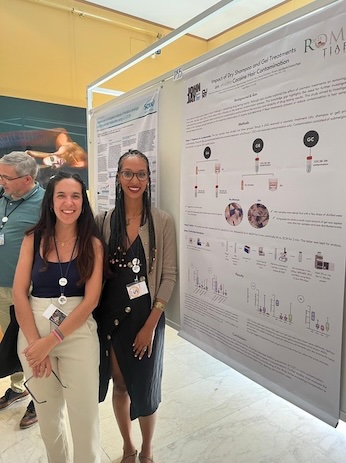
2023 - Society of Hair Testing Meeting
June 7th–9th, 2023, Lisbon, Portugal
Student: Alex Dombroski
Professor:Dr. Ana Pego
Poster: The Effect of Henna and Bleach Treatments on Cocaine Hair External Contamination
Hair external contamination is a challenging phenomenon that may compromise hair testing interpretation. Previous research has focused on the influence of cosmetic treatments on the removal of drugs of abuse by observing a decrease in concentration levels inside of the hair shaft. However, little is known about the impact of these treatments on the external hair contamination procedure and whether they facilitate or diminish this type of contamination.The goals of the present study were to explore how henna and bleach treatments influence cocaine external contamination and to investigate if any of these treatments prevent or reduce cocaine outer contamination on hair samples of varying colors and shapes.

2023 - American Academy of Forensic Science 75th Annual Scientific Meeting
February 13th–18th, 2023, Orlando, Florida
Student: Liana Albano
Professor:Dr. Peter Diaczuk
Poster: An Analysis of Polymer-Coated Bullets Using Spectroscopic Methods
Polymer-coated bullets have gained in popularity in recent years, in part because their use can reduce the user’s exposure to heavy metals in the ammunition. This type of ammunition employs a synthetic jacket, in which the lead core is surrounded by a polymer. These polymer-coated bullets do not retain individualizing minutiae like standard bullets do, which means forensic scientists need to focus on probative information that may be gleaned from the polymer coating. Liana’s study compared two polymer-coated bullets (American Eagle® Syntech [red polymer] and Syntech Defense 9mm Luger® [blue polymer]), and studied the solubility, melting point, and molecular vibrations of the polymers. Both polymers differed for all three parameters and infrared spectroscopy confirmed the different chemical composition; the blue polymer had functional groups similar to dimethyl iso phthalate while the red polymer had functional groups to similar poly(ethylene glycol terephthalate).
2023 - American Academy of Forensic Science 75th Annual Scientific Meeting
February 13th–18th, 2023, Orlando, Florida
Student: Abigail Wilson
Professor: Dr. Peter Diaczuk
Poster: Open Fire
Bullets used in ammunition manufacture can be broadly divided into two categories, full metal jacketed and jacketed hollow points. A jacketed hollow point bullet is designed to open or expand when it comes into contact with a viscous medium such as tissue and will create a different wound pattern. Abigail measured the expansion patterns for a representative brand of jacketed hollow point bullets used in a common caliber cartridge, the 9mm Luger. This research used ballistic gelatin of different thickness (3 inches, 2 inches, 1.5 inches, 1 inch, and 0.5 inches) as a tissue simulant with a chamois overlay as a substitute for skin. Bullet expansion was determined by measuring and averaging the distance between all opposing petals; the averages were 12.47mm for 3 inches, 12.23mm for 2 inches, 11.83mm for 1.5 inches, 11.84mm for 1 inch, and 11.49mm for 0.5 inches. The differences correlate to the gelatin thickness. As the gelatin slices get thinner, the width of the expanded bullets gets narrower.
2023 - American Academy of Forensic Science 75th Annual Scientific Meeting
February 13th–18th, 2023, Orlando, Florida
Students: Genesis Echavarria and Ines Cedillo-Cruz
Professor: Dr. Mechthild Prinz and Dr. Nicholas Petraco
Poster: Studying biological factors affecting DNA shedding propensity
Determining the probative value of DNA traces, especially in the absence of body fluid attribution, requires the consideration of passive transfer scenarios. One factor playing a role is the well-established variation in individual shedding propensity. In some circumstances (e.g., with an uncooperative or deceased person of interest), it may be necessary to predict the relevant shedding propensity based on other physical characteristics. This study attempted to correlate individual characteristics to the amount of DNA recovered from a person’s hands. Possible correlations were found with gender, age, and the number of times a volunteer involuntarily touched their face or another skin area. Other tested parameters like BMI, skin hydration, sebum content, sweating propensity, or tanning characteristics did not have an effect.
2022 - American Northeastern Association of Forensic Scientists Annual Scientific Meeting
October 17th–21st, 2022, Niagara Falls
Student: Falyn Vega
Adjunct Professor: Andrew Schweighardt
Presentation: Extraction of Challenging Forensic Samples Using the MicroGEM DNA Extraction Kit
DNA extraction is an essential process in forensic investigations and the DNA typing success rate depends on the yield and quality of recovered DNA. Falyn’s research explored the potential of a new enzyme being used in a DNA extraction known as forensicGEM by the manufacturer MicroGEM. The protocol offers complete DNA extraction in about 20 minutes in a single tube, thus limiting contamination, loss of sample, and working time and has been shown to successfully extract DNA from highly degraded samples. Falyn was able to show that the method worked well for small amounts of bones (10 mg compared to the standard organic extraction with 2 g) including two remains from the 9/11 World Trade Center attacks from which no detectable DNA had been previously extracted. The MicroGEM assay was able to yield a 22-locus and a 15-locus DNA profile on two of these highly degraded samples.
2022 - 29th Annual Scientific Meeting International Society for Forensic Genetics
August 29th–September 2nd, 2022, Washington, D.C.
Students: Ines Cedillo-Cruz and Genesis Echavarria
Professors: Dr. Mechthild Prinz and Dr. Nicholas Petraco
Poster on: Studying biological factors affecting DNA shedding propensity
Trace DNA found at a crime scene loses its probative value, if its presence can be explained by alternative scenarios not connected to the crime under investigation, for example passive transfer where somebody’s DNA is deposited at the scene via another person or an object. The probability of observing certain DNA results under a passive transfer scenario is affected by how much DNA an individual leaves behind when touching a surface. This study measured the amount of DNA collected from the fingers of washed hands from a group of 22 volunteers with the goal to evaluate individual differences and correlate DNA content to other biological characteristics. Dominant hand samples (60 minutes with activity) showed a higher average DNA concentration than non-dominant hands (30 minutes no activity), but this difference was not significant. The DNA results did not correlate to biological factors like melanin content, skin hydration, and BMI. There was some correlation between DNA concentration and finger sebum measurements, or self-declared sweating characteristics that will need to be explored.
2022 - American Academy of Forensic Science 74th Annual Scientific Meeting
February 21st–25th, 2022, Seattle, Washington
Student: Kayla Marschke
Professor: Dr. Marta Concheiro
Poster: A Sensitive Liquid Chromatography/Tandem Mass Spectrometry (LC/MS/MS) Method for the Simultaneous Quantification of 32 Drugs in Oral Fluid
There is an increased interest by law enforcement for roadside Oral Fluid (OF) testing for drugs including cannabis, opioids, stimulants, and benzodiazepines. This means there is also a bigger need for toxicology laboratories to develop for confirmation methods in OF. Kayla’s work focused on a sensitive method for the simultaneous detection of a panel of 32 drugs in OF collected by the Quantisal® device by LC/MSMS. The method tested for the following drugs: delta-9-Tetrahydrocannabinol (THC), amphetamine, methamphetamine, 3,4-Methylenedioxymethamphetamine (MDMA), 3,4,-Methylenedioxyamphetamine (MDA), cocaine, benzoylecgonine, cocaethylene, carisoprodol, meprobamate, zolpidem, alprazolam, clonazepam, 7-aminoclonazepam, lorazepam, diazepam, nordiazepam, oxazepam, temazepam, codeine, 6-monoacetylmorphine (6-AM), buprenorphine, fentanyl, hydrocodone, hydromorphone, methadone, morphine, oxycodone, oxymorphone, tramadol, ketamine, and Phencyclidine (PCP).
2022 - American Academy of Forensic Science 74th Annual Scientific Meeting
February 21st–25th, 2022, Seattle, Washington
Student: Stephen Daly
Professor: Dr. Peter Diaczuk
Oral presentation: Bullet Ricochet of Polymer Coated Bullets
Polymer coated bullets were designed to limit a shooter’s exposure to lead as well as to limit the amount of lead that would be released into the environment. However, there are difficulties with forensic firearms examination of this bullet type, e.g. there are typically no individualizing striations on a polymer coated bullet, and there is a need for more forensic studies. This project established the ricochet angle and velocity for synthetic versus full metal jacket bullets. The data was collected using 9 mm Luger Federal brand total synthetic jacket (TSJ) bullets and 9 mm Luger Federal brand full metal jacket (FMJ) bullets for the substrates sheetrock, sheet metal, and Durock cement boards. The TSJ bullets had a significantly lower average velocity (p-value of <0.00001), by a difference of 257 ft/s (feet per second) when compared to the FMJ average velocity. When the angles of ricochet were calculated each FMJ average angle was lower than the corresponding TSJ average angle, except in two instances. Many of the impact marks showed a red residue left behind which could have come from the red polymer coating of the bullets.
2022 - American Academy of Forensic Science 74th Annual Scientific Meeting
February 21st–25th, 2022, Seattle, Washington
Student: Victoria Andre
Professor: Dr. Peter Diaczuk
Poster: Effects of improper Ammunition Storage
Firearms are commonly used by law enforcement, hunters, and civilians either for protection, sport or criminal activity. Ammunition for traditional firearms such as rifles and handguns consists of a cartridge case, propellant, a bullet (projectile), and primer.2 Ammunition can fail. The types of malfunctions that are commonly seen in ammunition are misfire, stovepipe, hang fire, double feed, squib load and misfeed. Improper ammunition storage is a major factor that plays a role in ammunition failure, especially if a leak covers the cartridges with an external liquid. Victoria’s study observed how ammunition function is affected when it is improperly stored in the following materials: water, soil, Hoppes 9 Solvent (a gun bore cleaner that contains kerosene, ethyl alcohol, and ammonium hydroxide), and WD-40, (a water-displacing spray that contains aliphatic petroleum distillates and petroleum base oil). This research showed that although some of the affected distressed cartridges fired successfully with the expected velocity, the majority of the cartridges exhibited changes such as ammunition failure (misfires, stovepipe, and double feed), low velocity and anomaly velocity measurements. All of the tested liquids had an adverse effect on the cartridges, with Hoppes 9 Solvent being the most detrimental.
2021 - American Academy of Forensic Science 73rd Annual Scientific Meeting
February 15th–19th, Virtual
Student: Alan Lee
Poster: Estimating Muzzle-to-Target Distance from the Physical Characteristics of a Bullet Hole
Determining the muzzle-to-target distance of a firearm discharge is an integral part in crime scene reconstruction. When combined with the bullet’s trajectory and impact angle, the shooter’s location can be approximated, which can support or refute eyewitness accounts and suspect statements. This study sought to develop a method using physical damage patterns of a bullet hole to determine the muzzle-to-target distance. Test fires were conducted with a .22 caliber rifle over a range of muzzle-to-target distances on plywood and Medium Density Fiberboard (MDF) panels. The results show that as muzzle-to-target distance increases, bullet hole depth decreases. This trend was steeper in the plywood substrates than MDF. Using the data from the test fires, a mathematical model was able to predict depth given the substrate material, muzzle-to-target distance, and bullet speed. A visual model that relates the depth of the bullet hole to the muzzle-to-target distance can extrapolate the distance, as long as substrate, firearm, and cartridge information are obtained from the scene.
2021 - American Academy of Forensic Science 73rd Annual Scientific Meeting
February 15th–19th, Virtual
Student: Xiao Chen
Talk: Evaluating a Test for Shedding Propensity Using Tape Lifts from Different Skin Locations
The shedding propensity of a person can assist data interpretation in casework when assessing the possibility of passive transfer for DNA analysis results. Currently, there are different methods to determine shedding propensity, all based on evaluating palmar skin (finger) deposits, but there is no standardized method, especially for an uncooperative suspect. This project tested the feasibility of testing sebaceous skin for shedding propensity through collecting skin surface tape lifts from eight different locations (washed and unwashed fingers from both hands, toe, and sebaceous skin areas like arm, ear, and nape). DNA yields were highest for the neck area below the ears followed by nape and unwashed fingers. Donors did not easily fall into different shedding propensity categories. Individual DNA values showed a continuous distribution from low to high concentrations. Correlations between sebaceous and palmar skin DNA yields were not strong enough to support substituting finger surface lifts with sebaceous skin locations.
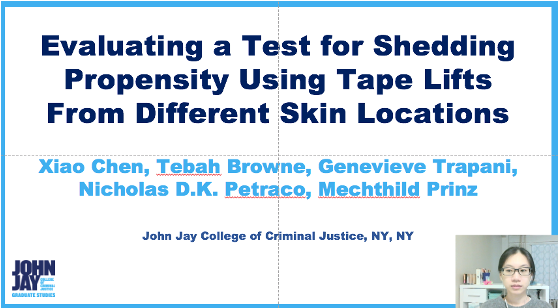
2020 - NEAFS Meeting
October 14th–17th, Virtual
Student: Genevieve Trapani
Study: Determination of Shedding Propensity Based on STR Results
Trace DNA evidence can be deposited at a crime scene due to either active or passive transfer. Based on previous studies, the probability of depositing a detectable amount of DNA through touch and the odds for passive transfer depend on the individual’s shedding propensity, and determining the shedding propensity of a person of interest can aid in trace DNA casework interpretation. As expected, STR results for unwashed hands showed a higher percentage of DNA mixtures. Accordingly, shedding propensity was determined based on STR profile quality and number of the expected alleles present for washed hands only. Out of the 28 volunteers, three individuals were consistently low shedders, the majority of 21 individuals were intermediate shedders, and only four individuals were high shedders. This distribution is similar to data from other studies.
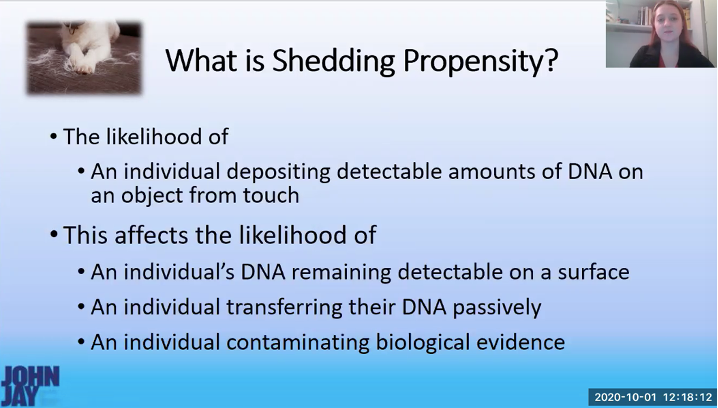
Screenshot of graduate student Genevieve Trapani presenting on shedding propensity.
2020 - American Academy of Forensic Science 72nd Annual Scientific Meeting
February 17th–22nd, Anaheim Convention Center, Anaheim, CA
Student: Natalia Platosz
Talk: Identification and Quantification of Classic, Prescription, and Synthetic Opioids in Hair by Liquid Chromatography Tandem Mass Spectrometry (LC/MS/MS)
Drug testing tools to monitor opioid use and abuse habits in both the living and postmortem are necessary to understand the opioid use pattern, identify risk groups, and cause of death. Hair is becoming an alternative matrix of increasing interest in forensic toxicology to investigate drug use and abuse patterns due to its long window of detection. This project tested 25mg of hair. The Limit Of Quantification (LOQ) was established to be 1pg/mg (3-methyl-fentanyl, 4-anpp, 4-methoxy-butyryl-fentanyl, acetyl fentanyl, acrylfentanyl, alfentanil, butyryl fentanyl, carfentanil, EDDP, fentanyl, furanyl-fentanyl, isobutyryl fentanyl, MT-45, para-fluorobutyryl fentanyl, sufentanil, U-47700, and valeryl fentanyl), 10pg/mg (6-acetylmorphine, hydrocodone, methadone, morphine, norfentanyl, oxycodone, oxymorphone, and tramadol), or 100pg/mg (codeine and hydromorphone). The method was fully validated following the Scientific Working Group for Forensic Toxicology guidelines. The parameters evaluated were linearity, limit of detection and LOQ, imprecision, accuracy, carryover, matrix effects, extraction efficiency, process efficiency, interferences, and autosampler stability.
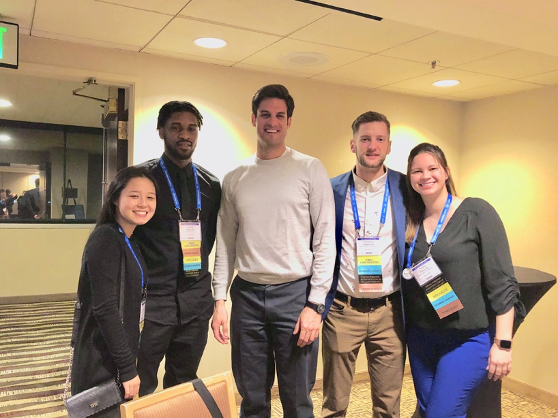
Students Christie Cannarozzi, Julian Beach, Professor Andrew Schweighardt, Christian Hopkins, and Natalia Platosz at the AAFS Meeting in Anaheim, CA, 2020
2020 - American Academy of Forensic Science 72nd Annual Scientific Meeting
February 17th–22nd, Anaheim Convention Center, Anaheim, CA
Student: Julian Beach
Talk: The Relationship Between Terminal Velocity and Glass Fracture via .177 Caliber Steel BBs
Drug testing tools to monitor opioid use and abuse habits in both the living and postmortem are necessary to understand the opioid use pattern, identify risk groups, and cause of death. Hair is becoming an alternative matrix of increasing interest in forensic toxicology to investigate drug use and abuse patterns due to its long window of detection. This project tested 25mg of hair. The Limit Of Quantification (LOQ) was established to be 1pg/mg (3-methyl-fentanyl, 4-anpp, 4-methoxy-butyryl-fentanyl, acetyl fentanyl, acrylfentanyl, alfentanil, butyryl fentanyl, carfentanil, EDDP, fentanyl, furanyl-fentanyl, isobutyryl fentanyl, MT-45, para-fluorobutyryl fentanyl, sufentanil, U-47700, and valeryl fentanyl), 10pg/mg (6-acetylmorphine, hydrocodone, methadone, morphine, norfentanyl, oxycodone, oxymorphone, and tramadol), or 100pg/mg (codeine and hydromorphone). The method was fully validated following the Scientific Working Group for Forensic Toxicology guidelines. The parameters evaluated were linearity, limit of detection and LOQ, imprecision, accuracy, carryover, matrix effects, extraction efficiency, process efficiency, interferences, and autosampler stability.
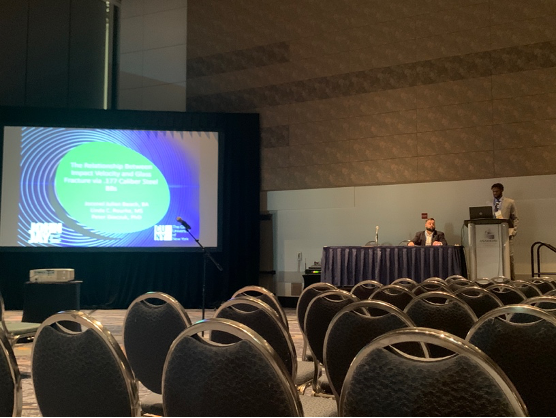
Julian Beach presenting at the AAFS Meeting in Anaheim, CA, 2020
2020 - American Academy of Forensic Science 72nd Annual Scientific Meeting
February 17th–22nd, Anaheim Convention Center, Anaheim, CA
Student: Christian Hopkins
Study: Further Evaluation of a Dry Vacuuming Technique for Recovery of DNA From Handwritten Documents
A John Jay team has developed a non-destructive homemade vacuum method for collecting biological material from handwritten documents that preserves the integrity of fingermark and indentation evidence. Currently forensic laboratory first process paper for indented writing, then for latent prints, but reversing this would increase DNA yields and minimize contamination. The method was evaluated on handwritten documents on different types of paper. The quantity of recovered DNA varied from donor to donor, but showed a trend correlated to the different sizes and surface properties of the tested paper types. Copy and notebook paper had the same size, but copy paper is rougher and yielded more DNA. Deposit slips with their smooth surface and small size had a very low DNA yield. The vacuum did not work well on manila envelopes as these were too thick to allow for air to pass through and the vacuum had less suction. Magazine paper is very thin and a difficult substrate. Friction ridge detail quality was not affected on either paper type and the new method proved to be feasible for non-destructive DNA collection.
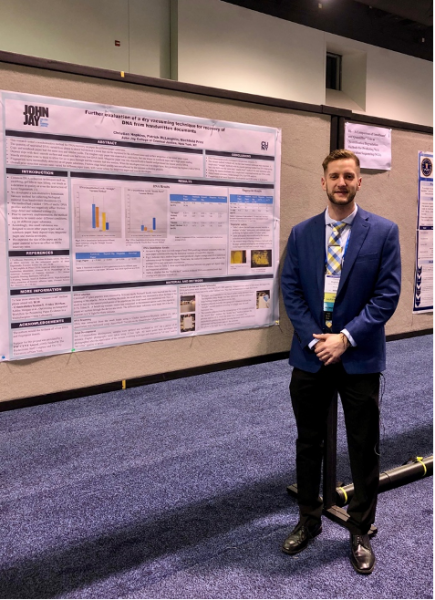
Graduate Student Christian Hopkins with his poster on DNA recovery from handwritten documents
2020 - American Academy of Forensic Science 72nd Annual Scientific Meeting
February 17th–22nd, Anaheim Convention Center, Anaheim, CA
Student: Natalee Small-Davidson
Study: The Reproducibility of Individual DNA Deposits Detected With Diamond Dye
Contact traces are an important part of DNA casework in all crime laboratories and, with optimized recovery, detection, and interpretation methods, many samples now lead to positive associations to a person of interest. The probative value of these associations and the possibility of passive transfer need to be considered carefully and individual variation on how much DNA is left behind (shedding propensity) is an important factor. In 2018, Kanokwongnuwut et al. published a method for testing shedding variability based on DNA staining and cell counting, this project aimed at reproducing this work. Fingerprints were collected from unwashed and washed fingers in triplicate over three weeks. There was variation over the three weeks especially for unwashed fingers. It was possible to rank volunteers as heavy and low shedders. In conclusion: in our hands, the method was not as reproducible as described, but showed a similar distribution of heavy, intermediate, and light shedders.
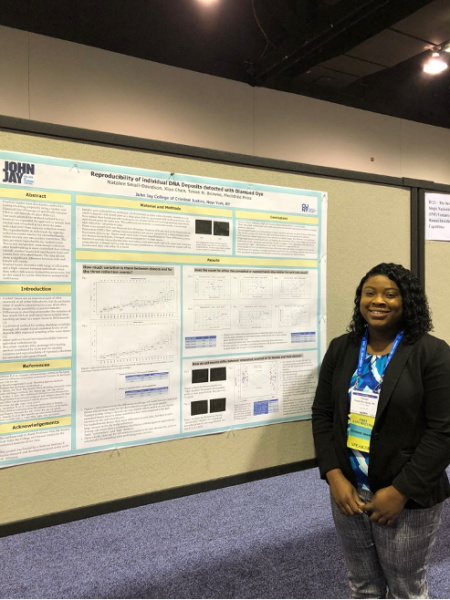
Graduate Student Natalee Small-Davidson with her poster on cell counts in fingerprints
2019 - NEAFS Meeting
November 12th–16th: The Lancaster Marriot, Lancaster, PA
Student: Julian Beach
Study: The Relationship between Terminal Velocity and Glass Fracture via. 177 Caliber Steel BBs
Glass is an abundant material in the environment, and can also be an abundant material found at crime scenes. It may often be the only thing between a bullet and its intended target, which is where fractography is necessary. Fractography is the study of fractured materials, such as glass. The majority of bullets will perforate or shatter most categories of glass; however, in some cases, the bullet may not have sufficient energy to shatter the glass at all. Correlating the terminal velocity of the projectile to the degree of glass fracture can provide useful information regarding the muzzle-to-target distance for a particular firearm/ammunition/glass combination. The experimental methodology was developed through pilot studies covering suitable muzzle-to-target distance ranges, the number of pumps required to pressurize the air rifle propulsion system, and the means of measuring the ricochet distance for projectiles which do not perforate the glass substrate. The goal of this research was to characterize the relationship between impact velocity and glass fracture pattern which can be useful in crime scene reconstruction.
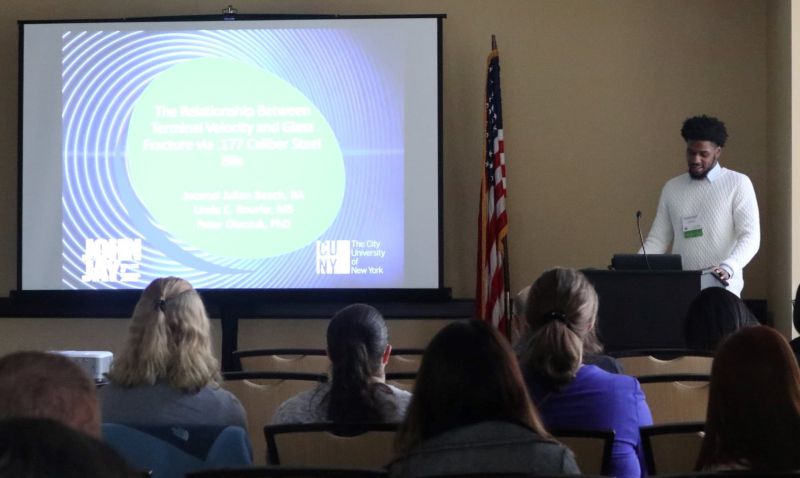
Graduate Student Julian Beach presenting on bullet velocity measurements
2019 - NEAFS Meeting
November 12th–16th: The Lancaster Marriot, Lancaster, PA
Student: Jaclyn Beshlian
Study: A Microspectral Analysis of Synthetic Wig Fibers
An microspectrophotometer (MSP) enables the scientist to collect absorption and fluorescence spectra of colored samples without destroying the piece of evidence itself. The information can be used to distinguish fibers similar in color from each other. This study used an MSP determine whether differentiation between 20 visually similar light brown synthetic wig fibers was possible. Prior to any analysis with the MSP, the material of the fibers was verified through FT-IR ATR, as well as their optical properties. Using a lab-assembled MSP the absorbance measurements were obtained perpendicular and on a 45-degree angle to the polarizer. After the absorbance measurements were complete the fibers were then exposed to fluorescent light. The fluorescent lighting used contained a series of UV, blue, and green 102 excitation filter combinations. No single fiber displayed the exact same spectra to another, allowing differentiation. When combining the information obtained through the absorbance measurements and the three excitation filter combinations, differentiation of all 20 visually similar light brown synthetic wig fibers was achieved
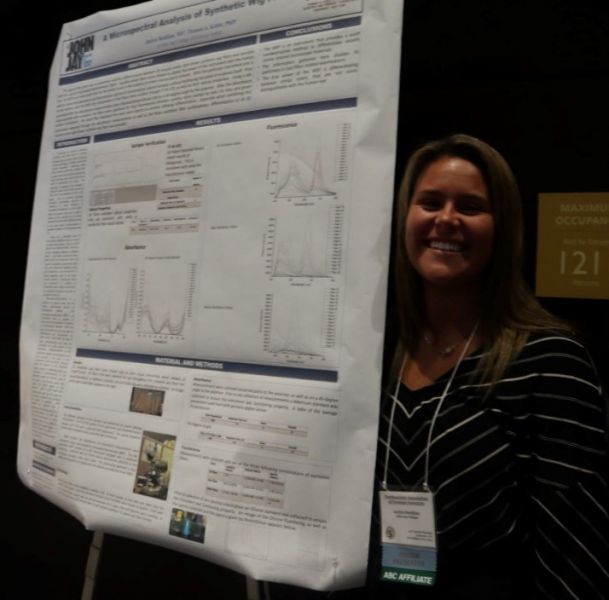
Graduate Student Jaclyn Beshlian pictured with her poster on synthetic wig fiver characterization
2019 - NEAFS Meeting
November 12th–16th: The Lancaster Marriot, Lancaster, PA
Student: Ashley Borrego
Study: An Exploration of Protein and DNA components in Fingerprint Components
The main focus of this project was to investigate the protein and DNA components in both sebaceous and eccrine fingerprints and explore a possible correlation to visual fingerprint residue. Twenty volunteers were instructed to touch their face to produce sebaceous prints, and five volunteers were instructed to wear gloves over a heat source to produce sweaty or eccrine prints. Microscopy was used to score the cellular debris of the right fingerprint on a scale of 1-4 based on density of cellular debris. The results of the study illustrated that sebaceous samples that sebaceous samples contained significantly more DNA than eccrine samples, while the number of proteins via mass spectrometry was similar. Accordingly, sebaceous samples had better STR results with 75% full profiles compared to the 20% full DNA profiles of eccrine samples. Linear regression results indicate a lack of correlation between cellular debris scores and DNA yields in sebaceous samples, a strong correlation between the cellular debris and DNA yield in eccrine samples, and moderate correlations between the cellular debris and number of proteins in both sample types. The results of this study provide additional information about donor variability/shedder status, and the content of DNA and proteins in fingerprint samples.
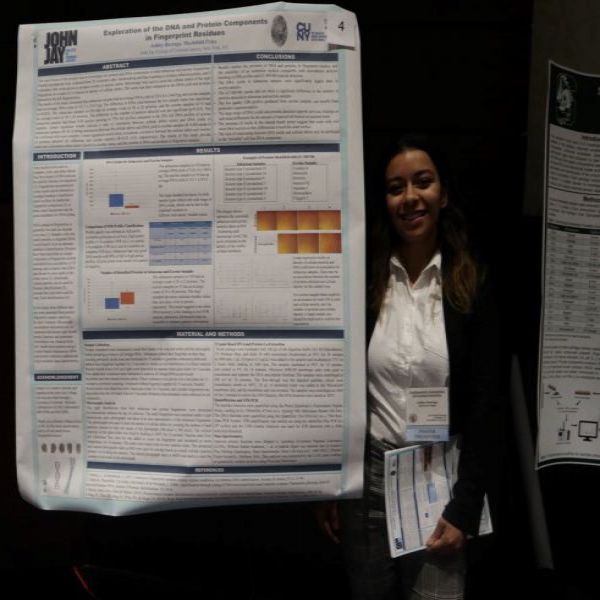
Graduate Student Ashley Borrego pictured with her poster on DNA and proteins in fingerprints
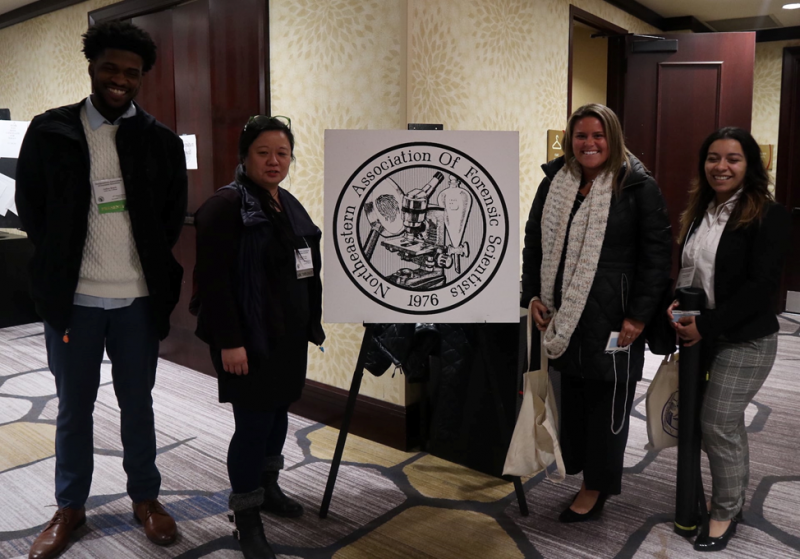
Julian Beach, Professor Linda Rourke, Jaclyn Beshlian, and Ashley Borrego at NEAFS Meetingin Lancaster, PA 2019
2019 - Congress of the International Society for Forensic Genetics
September 9th–13th, Prague Congress Center, Prague, Czech Republic
Student: Tebah Browne
Study: Semi-Quantitative Detection of Signature Peptide in Body Fluids by Liquid Chromatography Tandem Mass Spectrometry (LC-MS/MS)
This study covers a modified semi-quantitative approach to detecting signature peptides for body fluid identification. A liquid chromatography tandem mass spectrometer normally used for toxicology was adapted to detect target ion transitions for five semen or saliva specific peptides. Peptide concentrations were measured based on a mixture of synthetic peptide standards. Samples were processed using a three-hour trypsin digestion and Microcon membrane filtration. This method generates PCR compatible DNA and peptide fractions that can be typed without any further treatment. Preliminary validation tests covered stains on different substrates, semen/saliva mixtures, limit of detection, and repeatability. All signature peptides were present at different concentrations, varied amongst donors, and were tissue specific. Saliva peptides were detected at lower concentrations and had a higher limit of detection (LOD). Semen peptides had higher concentrations and were detected even as a minor component in a mixture. All semen peptides and all, but one, saliva peptides were detected on the various substrates. DNA fractions did not show signs of degradation or PCR inhibition. The results indicate that this assay is feasible for DNA and protein identification.
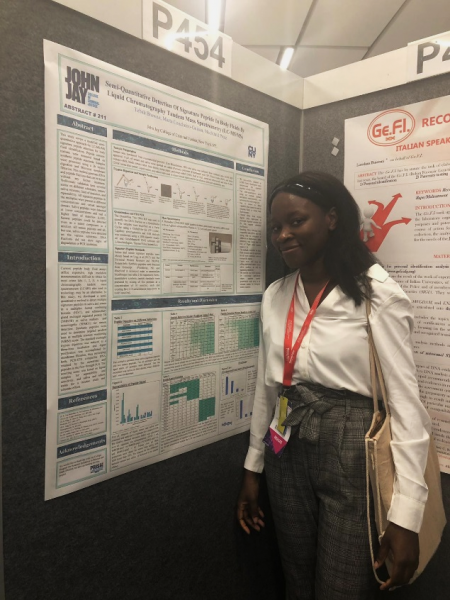
Graduate Student Tebah Browne pictured with her poster on protein based body fluid identification
2019 - NEAFS Meeting
November 12th–16th, The Lancaster Marriot, Lancaster, PA
Student: Dino Robinson
Award: George W. Chin Memorial Scholarship
Graduate Student, Dino Robinson, was honored with a George W. Chin Memorial Scholarship award at the 2019 North Eastern Association of Forensic Scientist Meeting. This award is given to students who display excellence in his/her academic program.
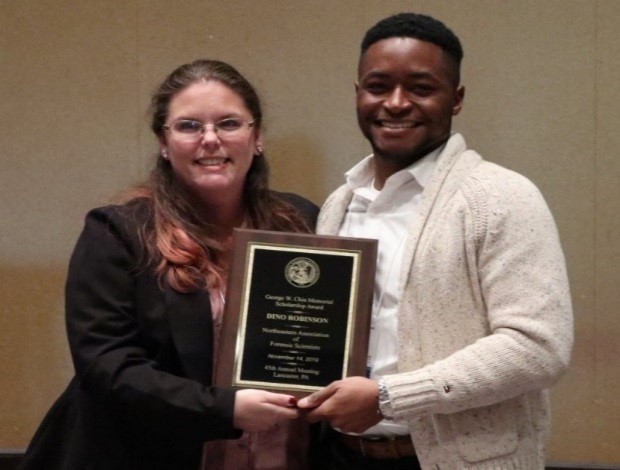
Graduate Student Dino Robinson and NEAFS Award chair Danielle Malone.
2019 - Society of Forensic Toxicologists (SOFT) Meeting
October 16th–18th, Grand Hyatt San Antonio, San Antonio, TX
Student: Victoria Mei
Professor: Marta Concheiro-Guisan
Award: SOFT Educational Research Award
Study: Validation of a Liquid Chromatography-Tandem Mass Spectrometry (LC-MS/MS) Method for the Quantification of 13 Designer Benzodiazepines in Postmortem Blood
The ease of purchasing designer benzodiazepines on the internet has increased their misuse. Their use for drug-facilitated sexual assaults is a growing threat. Their use as an alternative to prescription benzodiazepines causes major safety concerns, because the lack of dosage information can lead to unintended overdoses, coma, or death at higher doses for self-medicating users. More data on the quantification of designer benzodiazepines in forensic cases are needed. The main objective of Ms. Mei’s study was to develop and validate a method for the determination of 13 designer benzodiazepines in postmortem blood, to add to the in-house method that already included a limited number of common designer benzodiazepines. The validated method succeeded to simultaneously identify all 13 designer benzodiazepines in blood using solid phase extraction (SPE) and a 13.5-minute analysis on the LC-MS/MS, and proved to be simple, reproducible, sensitive, and robust.
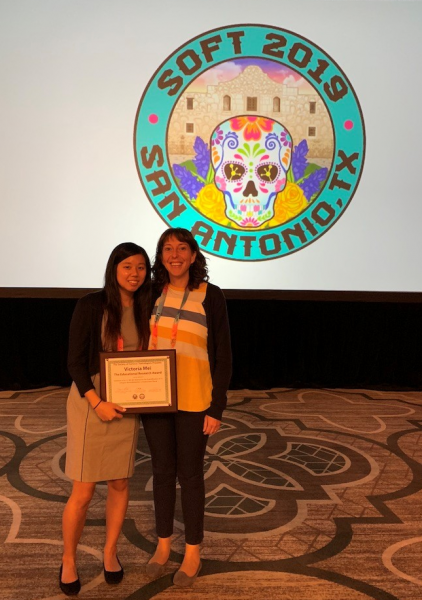
Graduate Student Victoria Mei with her mentor Marta Concheiro-Guisan
2019 - American Academy of Forensic Science 71st Annual Scientific Meeting
February 19th–22nd, Baltimore Convention Center, Baltimore, MD
Student: Patrick McLaughlin
Study: Improved DNA Recovery from Handwritten Documents
When paper evidence is submitted for evidence recovery, a common practice is to prioritize the chemical or physical development of latent prints prior to attempting any of the various methods of DNA extraction from the prints. Areas of the periphery are commonly targeted for print visualization where people most commonly hold and lift sheets of paper. The written text is rarely considered an area of interest for criminalists but has the potential to retain “touch” DNA evidence deposited when the writer of scraped their hand across the page during the writing process. In this study we asked male and female volunteers to produce handwritten documents. Additionally, a “field case” study was performed where volunteers provided a writing sample prior to and after a mild aerobic exercise period. The writing samples were then vacuumed using an irradiated and trimmed glass pipette containing a moistened cotton Puritan swab with a vacuum hose attached to the narrow end of the pipette. The quantity of recovered DNA varied greatly from donor to donor, but most of the collected samples provided sufficient material to for STR typing and successful comparisons to the reference samples. This technique did not affect latent print and indented markings. Additionally, the process does not damage the document, which may be of importance for prosecutorial value and court demonstration.
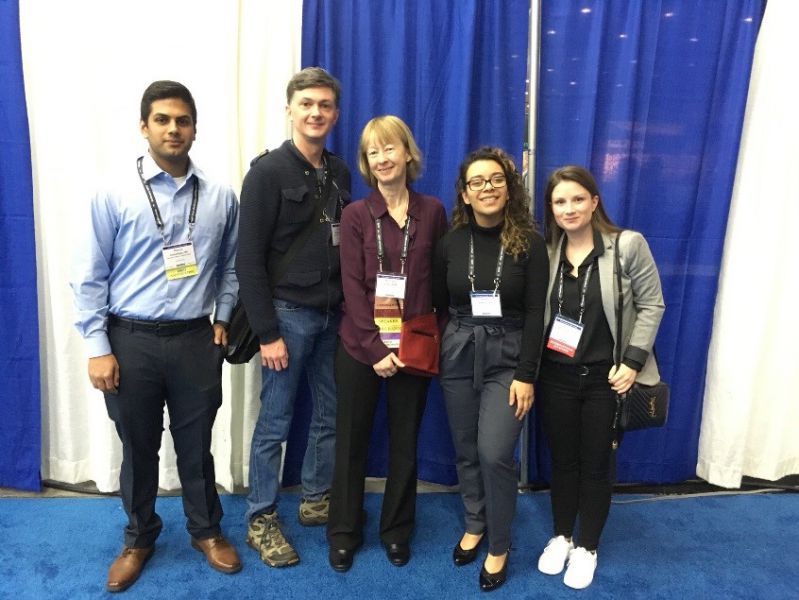
Graduate Student Patrick McLaughlin with Professor Prinz and other members of the Prinz research group
2018 - NEAFS Meeting
October 23rd–27th, The Sagamore Resort, Bolton Landing, NY
Students: Niti Dalal and Patrick McLaughlin
Professor: Dr. Mechthild Prinz
Poster: Optimizing a method for DNA recovery while preserving latent prints on paper
The evidence in criminal cases like kidnapping, extortion and bank robberies often consists of handwritten paper documents where both latent print processing and DNA collection are important. This project tested a workflow, where adhesive tape and dry swabs were used to remove DNA from the surface of the paper without destroying the fingerprint pattern underneath. With a higher DNA yield and better success rates for fingerprints, tape was more suitable than swabs. Tape DNA collection even worked after latent prints had been made visible through fluorescent powder.
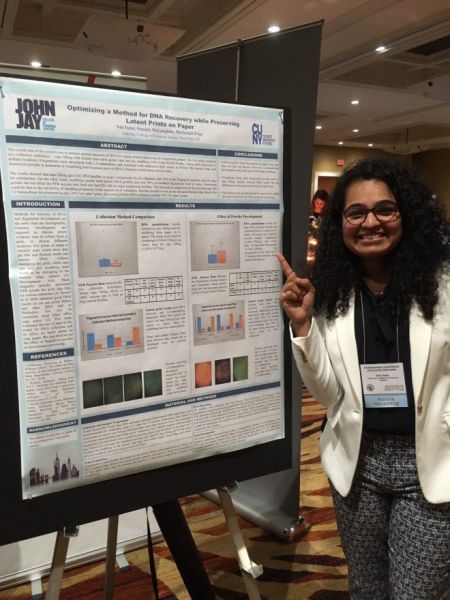
Graduate student Niti Dalal pictured in front of her poster
2016 - NEAFS Annual Meeting
October 12th - 16th, Harrah’s Resort and Casino, Atlantic City, New Jersey
Students: Melissa Branker, BSc
Professor: Jennifer Rosati, PhD
Poster: The importance of resource quality and species interactions on the colonization behavior of the black blow fly, Phormia regina (Meigen).
Within minutes after death, the process of decomposition occurs, which modifies the morphology and structure of a corpse (Campobasso et al, 2001). During decomposition, there are a wide variety of insect groups that arrive and utilize carrion with a distinct pattern of insect succession (Campobasso et al, 2001). There are many forensically important Dipteran species that are known to colonize a decomposing carcass during the early stages of decomposition, which include the families of Calliphoridae (blow flies), Sarcophagidae (flesh flies) and Muscidae (house flies). Within the first few hours post-mortem, blow flies are known to have high levels of recruitment to the resource (Campobasso et al, 2001). As a result, blow flies are commonly used as indicators to determine the minimum time of colonization (MTC); which can be helpful in post-mortem interval (PMI) estimations. However, the colonization behavior of these indicator species can be influenced by a variety of factors including oviposition preference (Campobasso et al, 2001), pheromone cues (Yang and Shiao, 2012, Akol et al 2013), bacterial cues (Lam et. al 2007, Zheng et al 2013) as well as inter- and intra- specific interactions. (Giao and Godoy, 2007, Yang and Shiao, 2012). This research utilized two forensically relevant blow fly species: Lucilia sericata (Meigen) and Phormia regina (Meigen) to examine the effects of resource quality and species interactions on the oviposition behavior of blow flies. We hypothesize that both resource quality and the presence of L. sericata eggs will alter the colonization behavior of P. regina.
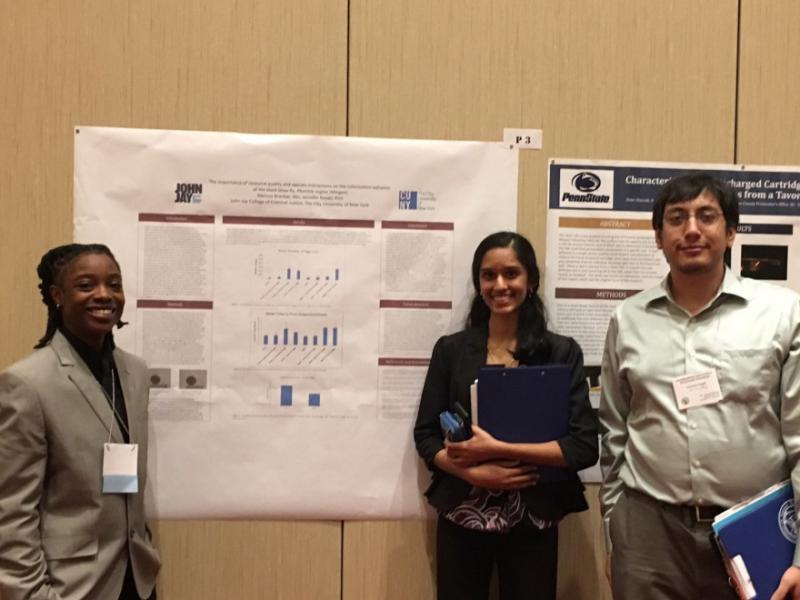
Team Rosati pictured in front of Melissa's poster on Forensic Entomology
(Graduate students Melissa Branker, Vincent Nappi, and undergraduate Veena Mehta)
2016 - 54th Annual Meeting of TIAFT
August 28th – September 1st, 2016, Brisbane, Australia
Student: Briana Miller
Professor: Dr. Marta Concheiro-Guisan
Study: Stability of Synthetic Cathinones in Preserved Oral Fluid Specimens
Dr. Nikolas Lemos wanted to commemorate the 20th anniversary of his graduation from John Jay with a master’s degree in Forensic Science, and honor his late mentor, Professor Agarwal by sponsoring a current graduate student to attend the 2016 meeting of TIAFT, to be held in Brisbane, Australia. Briana Miller was that lucky student and she had the opportunity to present her paper on “Stability of Synthetic Cathinones in Preserved Oral Fluid Specimens”.
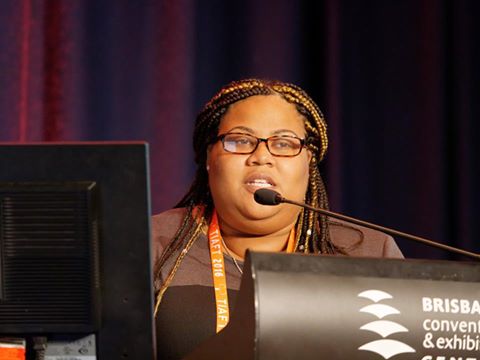
2016 - American Association for Crime Scene Reconstruction Training Conference
Clark, New Jersey
Student: Tara Goldfrank
Professor: Peter Diaczuk, PhD
Study: Critical Angle Determination & Angle of Ricochet on Windshield Glass
Bullet trajectories are a critical element in crime scene reconstruction. This study explores the variability of ricochet angles specifically for windshields since shooting events often include vehicles.
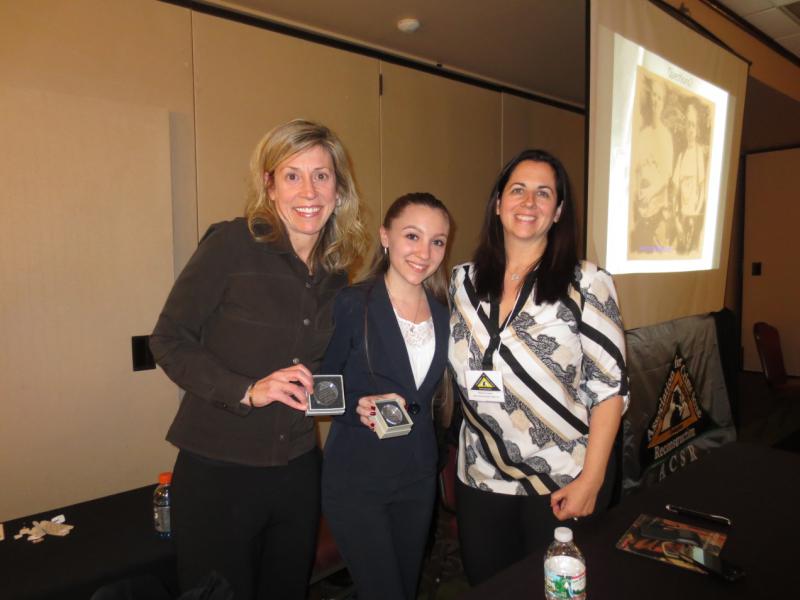
2014 - Eastern Analytical Symposium and Exposition
Somerset, NJ
Student: Kristi Tami
Professor: Dr. Gloria Proni
Poster: Spectroscopic Characterization of Organophosphate Compounds
Most commercially important insecticides and lethal chemical warfare agents belong to the category of organophosphate compounds. Their mode of action is related to the accumulation of acetylcholine at the synapses that culminates in respiratory failure and neurological damage. We are investigating the toxicity of selected organophosphate compounds in respect to their structures' spatial differences.
2014 - 66th Annual Scientific Meeting of the American Association of Forensic Science
Seattle, WA
Student: Theron Ng-A-Qui, B.S.
Professors: Bruce Eng, J.D.; Shu-Yuan Cheng, Ph.D.
Poster: Extraction process efficiency study of cathinones by solid phase extraction
This study explored current limitations when dealing with synthetic drugs. Despite the increased availability of designer drugs, few studies have focused on the analytical extraction techniques for their detection and quantification in biological samples. With solid phase extraction (SPE) being the most commonly used technique for sample preparation, it is important to know the rate at which the target substances are being recovered. The results indicate that the Strata X Drug B SPE extraction was able to recover higher percentage of cathinone and mephedrone at medium (100 ng/ml) and high (500 ng/ml) concentrations, but not at low (10 ng/ml) concentration.
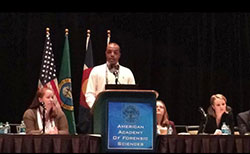
2013 - NEAFS Annual Meeting
September 25th – 28th, 2013, Cromwell, CT
Student: Laura Pritchard
Poster: Establishing a method to determine the Statistical Value of Fiber Evidence
Recent MS-FOS graduate Laura Pritchard presented her poster on "Establishing a method to determine the Statistical Value of Fiber Evidence". Dryer lint from 14 dryers was collected to show that each crime scene can be unique. A sample from each was mounted on its own microscope slide and then analyzed with a polarized light microscope. Color, cross sectional shape, parallel refractive index, perpendicular refractive index, dichroism, and birefringence of each fiber in the sample sets were captured and data were analyzed using Fisher’s Exact test. Her mentor for this project was Professor John Reffner.
